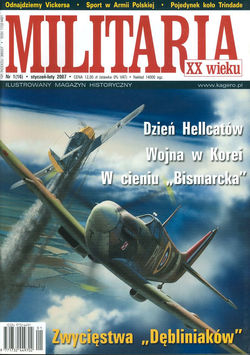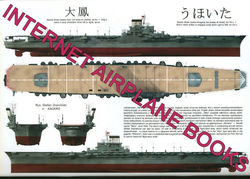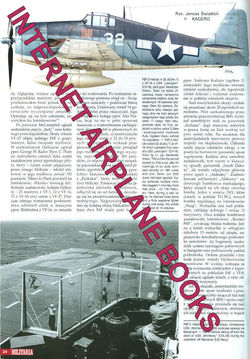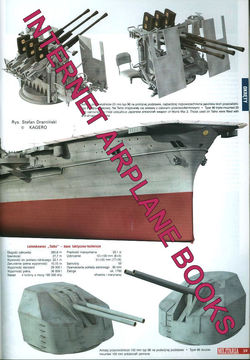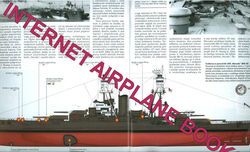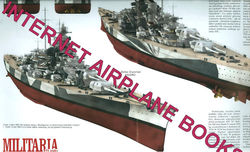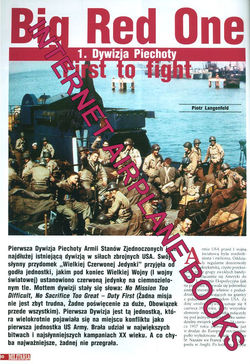KAGERO MILITARIA Nr1(16) WW2 RAF
No.315 SQN_IJN TAIHO_AVG P-40_BISMARCK_F6F_IL-2_USS NEVADA
SOFTBOUND
***TEXT IS IN POLISH LANGUAGE WITH LIMITED AMOUNT OF ENGLISH***
GERMAN
BATTLESHIP BISMARCK & TIRPITZ COLOR FOLDOUT POSTER
WW2
ROYAL AIR FORCE No.315 (POLISH) SQUADRON SUPERMARINE SPITFIRE
AMERICAN
VOLUNTEER GROUP AVG FLYING TIGERS CHINA CURTISS P-40
WW2
US NAVY GRUMMAN F6F HELLCAT VF USN
BATTLESHIP
USS NEVADA ESCAPES FROM PEARL HARBOR ATTACK
FROM
STALINGRAD TO BERLIN: WW2 RUSSIAN RED AIR FORCE VVS ILYUSHIN IL-2M3 STORMOVIL
ATTACK PLANE
EASTERN
FRONT BOBRUYSK 1944
WW2
US ARMY BIG RED ONE (AFRICA 1942-1943, NORMANDY 1944, VIETNAM WAR
WW2
JAPANESE AIRCRAFT CARRIER IJN TAIHO
-------------------------------------------------------------------------------------------------------------------
Additional Information from
Internet Encyclopedia
Taihô was an aircraft carrier of the Imperial Japanese
Navy during World War II. Possessing heavy belt armor and featuring an
armor-plated flight deck (a first for any Japanese carrier), she represented a
major departure in Japanese carrier design and was expected to not only survive
multiple bomb, torpedo or shell hits but also continue fighting effectively.
Her name means "Great Phoenix".
Built by Kawasaki at Kobe, she was laid down on 10
July 1941, launched almost two years later on 7 April 1943 and finally
commissioned on 7 March 1944. She sank on 19 June 1944 during the Battle of the
Philippine Sea after suffering a single torpedo hit from the American submarine
USS Albacore, due to
explosions resulting from design flaws and poor damage control.
Heavy anti-aircraft armament on Taihô comprised twelve of the
brand-new 100 mm (3.9 in)/65 caliber Type 98 anti-aircraft guns
arranged in six twin-gun turrets: three on the port side and three to
starboard. The guns were electro-hydraulically powered but, in the event of a
power failure, could function manually at reduced effectiveness. Operated by a
crew of 11 men, the average firing rate was 15 rounds per minute with a maximum
effective horizontal range of 14 km (7.6 nmi; 8.7 mi) and a
maximum effective vertical range of 11 km (5.9 nmi; 6.8 mi).
In addition, Taihô carried 17 triple-mount 25 mm (1 in)
anti-aircraft autocannons (51 barrels total). Sixteen of these were mounted on
sponsons just below flight deck level: eight to port, six to starboard and two
at the stern. The seventeenth unit was positioned on the flight deck, just
ahead of the island. The triple-mounts were electrically powered (though manual
operation was possible) and normally required a crew of nine. They had a
practical firing rate of 110–120 rounds per minute and a maximum effective
range of 3 km (1.6 nmi; 1.9 mi). The 25 mm (1 in) Type
96 autocannon was the Japanese Navy's standard small-caliber anti-aircraft
weapon from 1936 through the end of the war in 1945 and was an adaptation of a
French design.
Taihô had
two Type 94 triaxially stabilized fire control directors, one mounted on the
flight deck ahead of the island and one amidships on the port side, just below
flight deck level. These controlled the 100 mm (3.9 in) AA gun
turrets and were electro-hydraulically powered. The 25 mm (1 in)
triple-mount machine guns were controlled by seven Type 95 fire control units,
each of which could direct the fire of two or three mounts.
Taihô's
original design made no provisions for radar installation as the Imperial
Japanese Navy did not possess any shipborne surface, fire control or air search
radar at the war's outset in September 1939. Not until January 1941, when a
Japanese naval technical mission arrived in Germany, did the IJN learn that
European nations were using pulsed radar for combat purposes. In August that
same year, the Navy Ministry initiated a crash plan to speed up radar
development, resulting in (among others) the Type 21 and Type 13 air search
radars.
Prior to completion in 1944, Taihô was fitted with two Type 21 air
search radars, one mounted atop the island on the anti-aircraft control
platform and one on the lower bridge deck at the aft end of the island. She
also had one Type 13 air search set installed with an antenna mounted on the
signal mast above the bridge. The Type 21 had a maximum effective range of
80 nmi (150 km; 92 mi) while the Type 13 had a range of
54 nmi (100 km; 62 mi)
Taihô's
planned air complement varied considerably throughout her design and
construction. Initially it was envisioned she would carry 126 aircraft (with 30
of these in reserve). Later this was pared down to 64, raised again to 78 and
finally reduced to 53. One reason for the discrepancy in numbers was (in sharp
contrast to the United States) the Imperial Japanese Navy's lack of insistence
that its carrier planes have the smallest possible folded wingspan (many
designs' folded only near the tips, while the wings of the Yokosuka D4Y Suisei
dive-bomber did not fold at all). Her aircraft capacity was also changed based
on previous wartime experience and the fact that Taihô was expected to carry larger newer-model carrier planes
still under development at the time of her construction: 24 Mitsubishi A7M2 Reppu "Sam" fighters, 25
Aichi B7A2 Ryusei
"Grace" torpedo bombers and four Nakajima C6N1 Saiun "Myrt" reconnaissance
planes. As none of these types were available at the time of her commissioning,
Taihô went to sea with
older-model aircraft.
Prior
to 13 June 1944, Taihô carried
65 aircraft: 22 Mitsubishi A6M5 Reisen (Zero) fighters, 22 Yokosuka D4Y1 Suisei "Judy" dive-bombers
(of which four were the D4Y1-C reconnaissance types), three Aichi D3A2
"Val" dive bombers and 18 Nakajima B6N2 Tenzan "Jill" torpedo bombers. By 19 June 1944,
however, the day the Battle of the Philippine Sea took place, she had already
lost nine aircraft due to various causes and had just 56 planes remaining for
actual combat.



